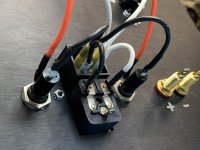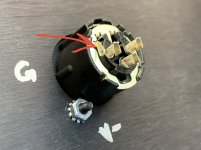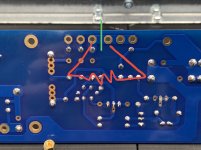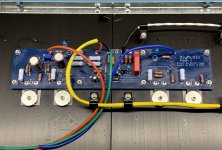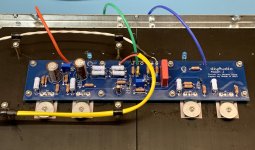Thanks guys , I'm about to test my PS today 🙂
Good luck! I'm slightly embarrassed to say that I was wearing my welding helmet when I flipped the switch for the first time. 😱

Side note, when unloaded, the power supply took nearly 15 minutes to bleed voltage to less than 1VDC. It holds the juice for quite some time. Since we’re discussing safety tonight, something else to be mindful of.
What is the value of your bleeder resistor (R9 and R10) on your PS boards?
Bleeder resistors are important, or else the caps just hold charge F-O-R-E-V-E-R.
If you need to discharge the caps quickly, I suggest building a safe electrolytic capacitor discharge probe:
High Voltage Vacuum Tube Electrolytic Capacitor Discharge Probe / Tool - BG074 - YouTube
But you may need to tweak the resistor value, have one discharge probe for low voltage electronics and one for high voltage electronics (tube).
Best,
Anand.
Last edited:
What is the value of your bleeder resistor (R9 and R10) on your PS boards?
Bleeder resistors are important, or else the caps just hold charge F-O-R-E-V-E-R.
If you need to discharge the caps quickly, I suggest building a safe electrolytic capacitor discharge probe:
High Voltage Vacuum Tube Electrolytic Capacitor Discharge Probe / Tool - BG074 - YouTube
But you may need to tweak the resistor value, have one discharge probe for low voltage electronics and one for high voltage electronics (tube).
Best,
Anand.
I chose a 4.7K 3W resistor for that duty. It doesn't cause problems for me (at least not that I can tell). But I did notice that it had been mentioned in the past that they'll store energy for a while, so I wanted to throw a number on that. I do appreciate the link to the discharge probe. I remember having those available on some high-power electronics in the military before we worked on them.
Once the amp boards are connected, they'll discharge much more quickly with a load.
This may be fun for some time estimates in the interim.
Blocked
Indeed IAIMH is right.
Also, depending on how loud you play your speakers (and how inefficient your speakers are), your heatsinks will run cooler since you are transferring some of that power to your speakers.
When a Class A amp is just sitting there not playing any music, they run warm ; but a little heat doesn't scare us

Best,
Anand.
I'd better quit while I'm ahead. 😀
Ah heck, I'll push my luck with a somewhat controversial subject.
Chris... how to connect XLRs can be an oft discussed subject. Note, below is noting that you have already used a gnd lift and have not cut the trace to separate low current return from high current return on your amp boards as is sometimes done.
The way I do it is:
Ignore the tab
Connect Pins 1, 2, and 3 to Audio GND, In+, and In- on your amp boards respectively.
Edited to add - Added "In" lest someone mistakenly connect their inputs to their VDC / rail connections. 😀
Ah heck, I'll push my luck with a somewhat controversial subject.
Chris... how to connect XLRs can be an oft discussed subject. Note, below is noting that you have already used a gnd lift and have not cut the trace to separate low current return from high current return on your amp boards as is sometimes done.
The way I do it is:
Ignore the tab
Connect Pins 1, 2, and 3 to Audio GND, In+, and In- on your amp boards respectively.
Edited to add - Added "In" lest someone mistakenly connect their inputs to their VDC / rail connections. 😀
I'd better quit while I'm ahead. 😀
Ah heck, I'll push my luck with a somewhat controversial subject.
Chris... how to connect XLRs can be an oft discussed subject. Note, below is noting that you have already used a gnd lift and have not cut the trace to separate low current return from high current return on your amp boards as is sometimes done.
The way I do it is:
Ignore the tab
Connect Pins 1, 2, and 3 to Audio GND, In+, and In- on your amp boards respectively.
Edited to add - Added "In" lest someone mistakenly connect their inputs to their VDC / rail connections. 😀
All sounds like my original plan. So no surprises. Nice!
I haven’t added the ground lift resistor (yet) since there aren’t any noise problems (yet).
Indeed IAIMH is right.
Also, depending on how loud you play your speakers (and how inefficient your speakers are), your heatsinks will run cooler since you are transferring some of that power to your speakers.
When a Class A amp is just sitting there not playing any music, they run warm ; but a little heat doesn't scare us
Best,
Anand.
Cool your amp by playing it loud! 🙂
Time to crank it up! Klipsches at the moment, so I’m going to have to turn it up extra loud, I reckon. Gotta put on something the wife will like, then. Usually I’m greeted with, “What in the hell are you listening to...” 😀
I haven’t added the ground lift resistor (yet) since there aren’t any noise problems (yet).
Your CL-60's from PSU GND <=> Audio GND to Chassis Earth are your ground lift. No need to double up in another location as far as I'm concerned. Again... grounding / ground lifts etc. are often discussed. It is certainly science, but I'm convinced the best engineers also play a bit in the dark arts. 😀
Your CL-60's from PSU GND <=> Audio GND to Chassis Earth are your ground lift. No need to double up in another location as far as I'm concerned. Again... grounding / ground lifts etc. are often discussed. It is certainly science, but I'm convinced the best engineers also play a bit in the dark arts. 😀
Ah, then I should be good. There was discussion on the noise thread about a resistor between “here” and “here” with a cut trace. I thought that’s what you were referring to. Good to go. 🙂
Attachments
You nailed it. That's another way / potentially an additional way to do it that I was referring to. Giving credit where credit is due, I learned of that from Extreme_Boky.
Ah, then I should be good. There was discussion on the noise thread about a resistor between “here” and “here” with a cut trace. I thought that’s what you were referring to. Good to go. 🙂
Hum bucking resistors and the like, as described by Andrew Russell of Hifisonix:
http://hifisonix.com/wordpress/wp-c...B-Design-Guidlines-for-Minimizing-Hum-1-1.pdf
That being said, I have found that using a differential input solves a lot and I never seem to have a 'hum' issue. My primary source (DAC) is differential.
Even when I played with vinyl I would use the XLR outputs (transformer coupled) and never had any hum issues to deal with.:
Poseidon's Voice Narada LP Phonostage
Best,
Anand.
Hum bucking resistors and the like, as described by Andrew Russell of Hifisonix:
http://hifisonix.com/wordpress/wp-c...B-Design-Guidlines-for-Minimizing-Hum-1-1.pdf
That being said, I have found that using a differential input solves a lot and I never seem to have a 'hum' issue. My primary source (DAC) is differential.
Even when I played with vinyl I would use the XLR outputs (transformer coupled) and never had any hum issues to deal with.:
Poseidon's Voice Narada LP Phonostage
Best,
Anand.
Yessir, that’s where I learned of it. Great news knowing about differential inputs. I’ve never had a device that wasn’t RCA-based. Looking forward to the silence. 🙂
I’m waiting for an Aleph P board set to arrive from HK so I can do the preamp side balanced as well. I also just picked up a Schiit Mani (not balanced) and have a new DL-103 cartridge on its way for my turntable to replace the 30yo cheapy. It's going to be a whole new world pretty soon!
Last edited:
Get some split washers in between the screw heads and the fender washers before you button it up for good, you can test in the meantime.
Looks very clean.
Looks very clean.
Get some split washers in between the screw heads and the fender washers before you button it up for good, you can test in the meantime.
Looks very clean.
Yes sir, will do. Thank you for the kind words. 🙂
- Home
- Amplifiers
- Pass Labs
- New Aleph J builder from Wisconsin, USA
